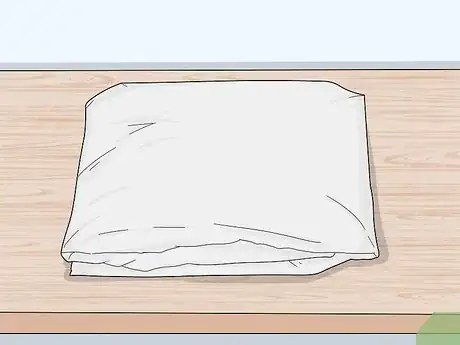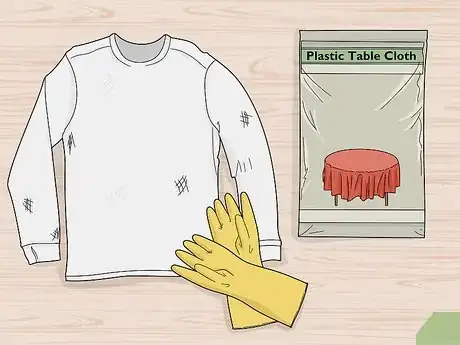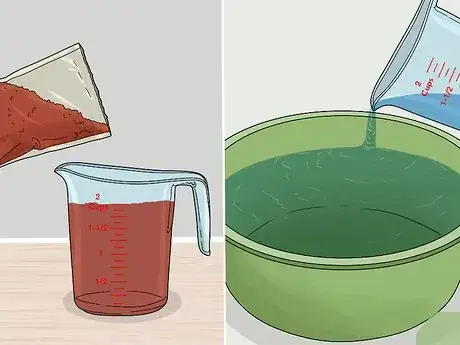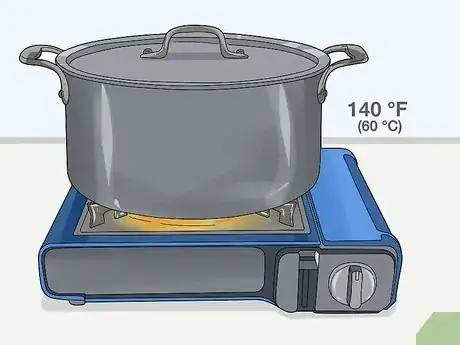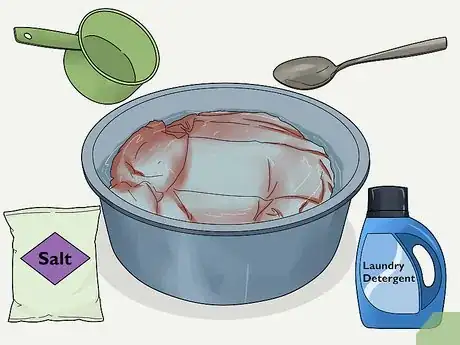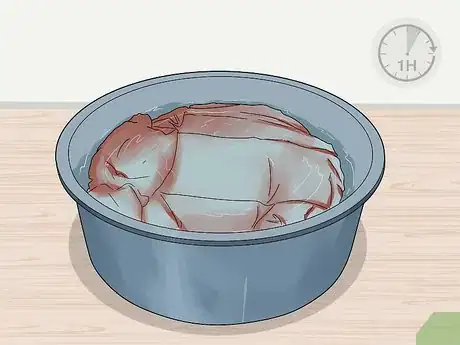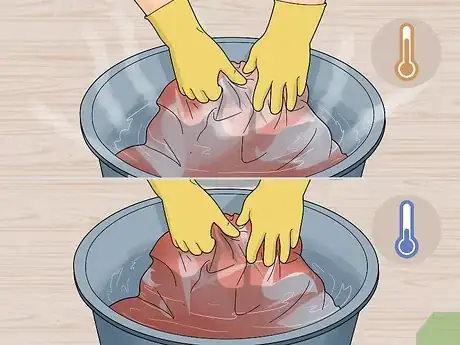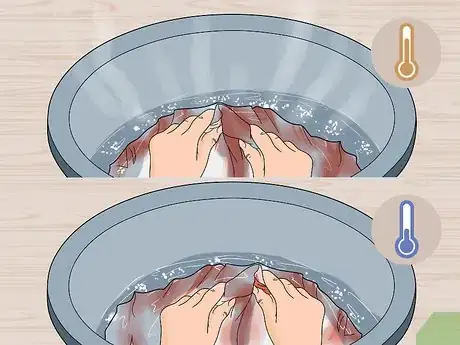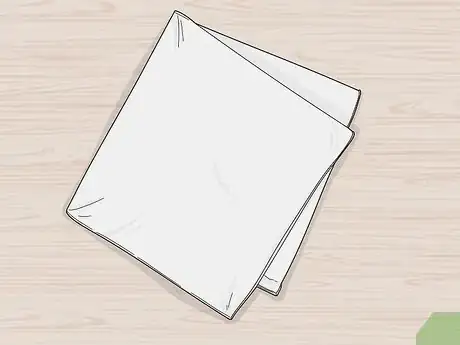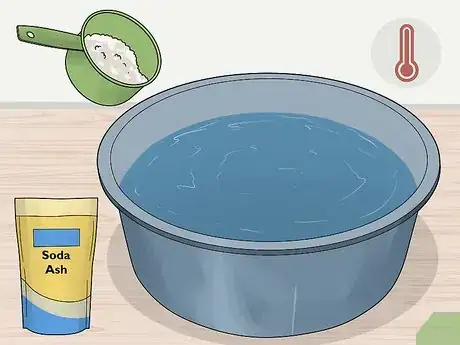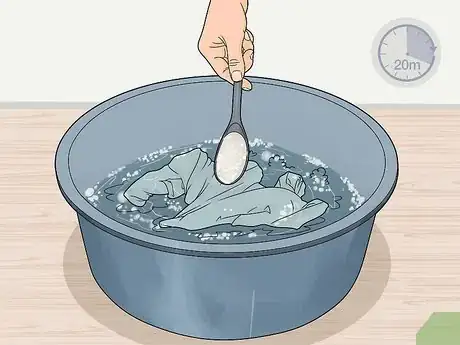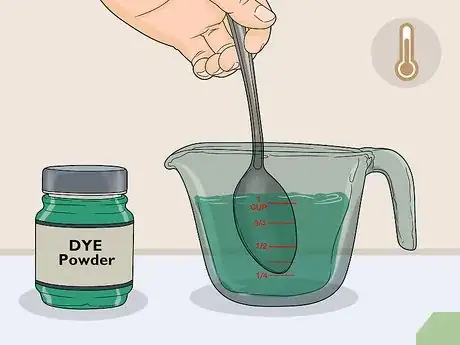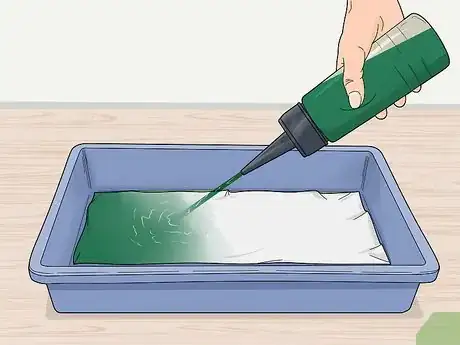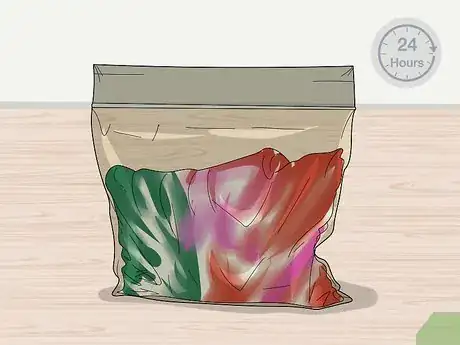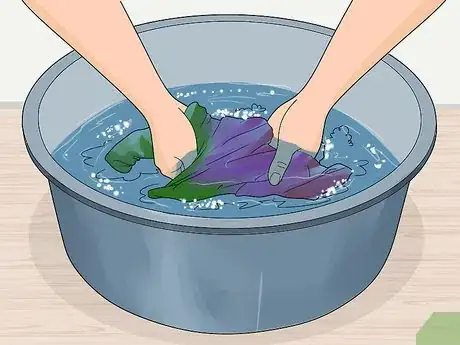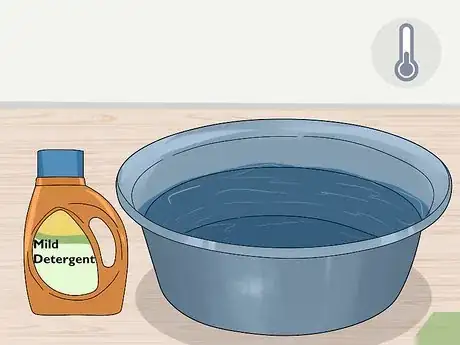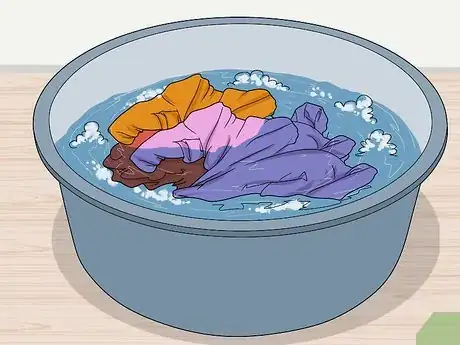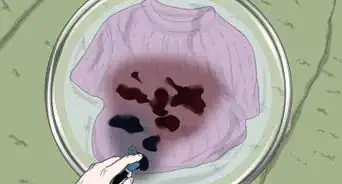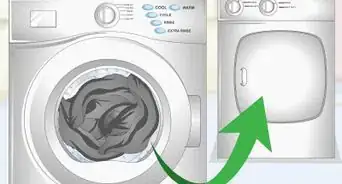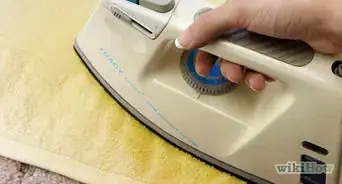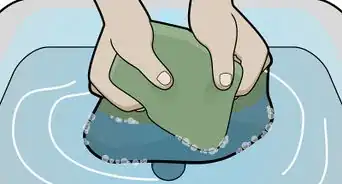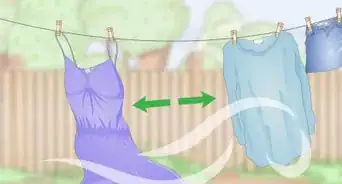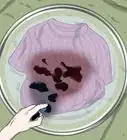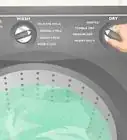This article was co-authored by wikiHow Staff. Our trained team of editors and researchers validate articles for accuracy and comprehensiveness. wikiHow's Content Management Team carefully monitors the work from our editorial staff to ensure that each article is backed by trusted research and meets our high quality standards.
This article has been viewed 30,557 times.
Learn more...
There is a certain beauty to hand-dyed fabric that regular fabric simply does not have. When it comes to linen, you can dye it with standard fabric dye from the store, or you can use a fiber reactive dye from a specialized online fabric dye shop. You can use similar methods to dye yarn as well--just wind the yarn into a skein first!
Steps
Using Fabric Dye
-
1Choose white linen fabric for best results. Dye is translucent, so it adds to whatever color is already in the fabric. If you want to get the same color as on the package, you need to start with a white base. If you want a more muted shade, however, try using gray linen instead.[1]
- You can try using this method to dye linen yarn. Wind the yarn around your arm to make a skein, then tie loose pieces of string around it to secure it.
-
2Protect your skin, clothing, and workspace against stains. Put on some old clothes you won't mind getting stained. Cover your workspace with a cheap, plastic tablecloth or plastic bags. Finally, pull on a pair or plastic or rubber gloves.Advertisement
-
3Stir the dye into 3 gallons (11.4 L) of water. How much dye and water you use depends how much fabric you are dyeing. In general, you will need to use the below proportions to dye 1 pound (454 g) or 3 yards (2.7 m) of fabric.[2]
- Powdered dye: dissolve 1 packet of powder in 2 cups (475 mL) of hot water first, then add it to the 3 gallons (11.4 L).
- Liquid dye: pour 1/2 bottle of liquid dye into 3 gallons (11.4 L) of water.
- Double the amount of dye for dark colors, such as black or forest green.
-
4Heat the dye to 140 °F (60 °C) in a pot over a stove. For smaller dye baths, you can use a large crockpot instead. You can take the dye bath off the stove, but it is better to keep the heat consistent over low to medium heat.[3]
- Do not use the same pots that you'd use for cooking.
-
5Add the fabric, then add some salt and laundry detergent. For every 3 gallons (11.4 L) of water, you will need 1 cup (300 g) of salt and 1 tablespoon (15 mL) of liquid laundry detergent into the dye bath. For best results, add the salt and laundry detergent 5 minutes after you add the fabric. This 5-minute delay will help keep the dye job consistent.[4]
- The salt and laundry detergent will help make the dye come out brighter and more consistent.
- Do not use soda ash like you would with fiber reactive dyes. Fabric dye is not the same thing as fiber reactive dye.
-
6Leave the fabric in the dye for up to 1 hour. The longer you leave the dye in the dye bath, the deeper the color will be. After 1 hour, however, you will have achieved the deepest possible result and should take the fabric out with a pair of metal kitchen tongs.[5]
- Keep the water hot for as long as the fabric is in the dye bath.
- Stir the fabric often to keep the color consistent.
-
7Rinse the fabric in warm and cool water. Rinse the fabric in warm water first to remove any surface dye. Rinse it again in cool water to get the rest of the excess dye out. Keep rinsing until the water runs clear.[6]
- Do not do this in a porcelain or fiberglass sink/tub or you risk staining.
-
8Hand wash the fabric with warm water, then rinse it with cool water. Wash the fabric by hand with warm water and mild detergent first. Rinse the fabric again in cool water, then hang it up to dry. You can use a dryer to speed up the process.
Using Fiber Reactive Dye
-
1Choose white linen for best results. Dye is translucent, so it only adds to the color that is already there. If you want the dye to appear like it does on the packaging, you need to start with a white base. If you prefer a muted shade, however, you could start with gray linen instead.
- You can try dyeing a cotton-linen or rayon-linen blend, but be aware that the results may not be consistent or even.
- If you are working with yarn, wind the yarn around your hand and elbow to create a large hank. Loosely tie pieces of string around the hank to secure it.
-
2Dissolve 1 cup (140 g) of soda ash in 1 gallon (3.8 L) of hot water. Use a funnel to fill a large jug with 1 cup (140 g) of soda ash. Add 1 gallon (3.8 L) of water that is around 105 °F (41 °C). Close the jug and shake it to dissolve the soda ash. Open the jug and set it aside so that the water can cool.[7]
- Use pure soda ash (sodium carbonate), not baking soda (sodium bicarbonate). You can find it online and in well-stocked craft stores.
- If you have hard water in your town or city, add some water softener. This will prevent the minerals from affecting the dye.
-
3Soak the linen in the soda ash solution for 20 minutes. Place your fabric or yarn into a plastic tub. Fill it with enough of the soda ash solution to completely cover the linen. Let the linen soak for at least 20 minutes. Save the rest of the soda ash for later.[8]
- The soda ash solution can still be hot for this step.
-
4Mix your dye according to the manufacturer's instructions. Each brand will be a little different, but in most cases, you will have to mix 2 teaspoons of fabric reactive dye powder with 1 cup (240 mL) of water. Mix the dye with a little bit of warm water to form a paste first, then add the rest of the water.[9]
- Wear safety googles and rubber of plastic gloves to protect your eyes and skin.
- Wear a dusk mask approved for fine particles for this step. Powdered fabric reactive dye is dangerous to breathe in.
- Use less dye for a lighter shade and more dye for a darker shade.
-
5Prepare more dye as needed, then pour it into applicator bottles. You don't have to use an applicator bottle if you won't want to, but many people find it easier to use than just pouring the dye from the container your prepared it in. How much more dye you prepare depends on how much linen you are dyeing; refer to the manufacturer's instructions for more advice.[10]
-
6Pour the dye onto the linen using the applicator bottles. Take the linen out of the soda ash bath, and squeeze out the excess solution. Set the linen down onto a plastic tray or bag, then squirt the dye onto it. You can create an all-over solid color or a splotchy color. You can even use multiple colors to create a tie dye effect.[11]
- Keep color mixing in mind. If you put 2 contrasting colors next to each other, they will form brown then they touch.
- Squeeze the linen after you apply the dye, then apply more dye if needed.
-
7Put the linen in a plastic bag and leave it someplace warm for 24 hours. If you dyed your linen multiple colors, be careful not to bundle it up. Arrange the linen so that no 2 colors touch or smoosh together. Zip or tie the bag shut, and leave it in a warm place for 12 to 24 hours.[12]
- The place should be at least 65 °F (18 °C).
- The longer you leave the linen in the bag, the brighter and more vibrant the colors will turn out.
-
8Rinse the linen in cold water. Don't worry, fiber reactive dyes are non-toxic, so they won't harm the environment or waterways. The soda ash can also unblock clogs in your sink! Keep rinsing until the water runs clear. It would be a good idea to rinse the linen afterwards with Synthrapol, which helps set the dye into the linen better.[13]
- You need to use Synthrapol with hot water; follow the instructions on the bottle. Make sure that no soda ash remains inn the linen before you start.
-
9Squeeze the excess water from linen and let it dry away from sunlight. Squeeze the linen with your hands until you get most of the water out. Spread it out on an old towel in a well-ventilated area away from sunlight. Allow it to air dry completely before using the fabric or yarn.
- Once the yarn is dry, snip the strings holding the skein together, then roll the skein into a ball.
Caring for Dyed Items
-
1Wash hand dyed linens separately the first 2 to 3 times. Even after all that rinsing, there is still a small chance that a small amount of dye may come off. To avoid staining the rest of your laundry load, wash the dyed linen by itself for the first 2 or 3 times. After that, you can wash it with other items.[14]
-
2Use cool water and a mild detergent. If possible, use a gentle setting on your washing machine. A mild detergent would be the best, but a non-bleaching detergent would be even better. Use a small amount of detergent to prevent fading.[15]
-
3Wash the linen with similar colors. To prevent color-transfer, wash light colors with light colors, and dark colors with dark. You can also wash all your reds, oranges, and pinks together in 1 load, and your blues, purples, and greens in another load. Yellows should be washed separately, like whites, because they are easily stained.[16]
- Always wash blacks separately from other colors.
-
4Never use bleach. If there is a stain that you need to get out, try a stain remover in a small area first. Bleach will remove the dye or cause it to change color, but a non-bleach stain remover should get the stain out.[17]
- If there's a stain, try to get to it as soon as possible while it is still wet.
-
5Hang your linen to dry to avoid creasing. Dryers are good for setting dye into the fabric, but after the initial tumble-dry, there is no need for it. Instead, smooth the linen out and hang it up to dry. You can iron it after it is completely dry for a crisper look.[18]
Warnings
- Do not use the same pots and stirring utensils that you use for cooking. Buy separate ones for dyeing.⧼thumbs_response⧽
- Do not dye or rinse your linen in porcelain or fiberglass sinks/tubs. If you do, you risk staining the porcelain or fiberglass.[19]⧼thumbs_response⧽
Things You'll Need
Using Fabric Dye
- Fabric dye
- Water
- Salt
- Liquid laundry detergent
- Large cooking pot
- Plastic gloves
Using Fiber Reactive Dye
- Linen
- Fiber reactive dye
- Soda ash
- Synthrapol
- Water softener (optional, for hard water)
- Dusk mask, certified for small particulates
- Safety goggles
- Plastic or rubber gloves
- Plastic jugs
- Plastic tub
- Plastic bags, preferably Ziploc
- Dye applicator bottles (optional)
Caring for Dyed Items
- Washer
- Mild detergent
References
- ↑ https://www.ritdye.com/techniques/tips-for-successful-dyeing/
- ↑ https://www.ritdye.com/techniques/tips-for-successful-dyeing/
- ↑ https://www.ritdye.com/techniques/tips-for-successful-dyeing/
- ↑ https://www.ritdye.com/techniques/tips-for-successful-dyeing/
- ↑ https://www.ritdye.com/techniques/tips-for-successful-dyeing/
- ↑ https://www.ritdye.com/techniques/tips-for-successful-dyeing/
- ↑ http://knitty.com/ISSUEsummer08/FEATdyeingplants.html
- ↑ http://knitty.com/ISSUEsummer08/FEATdyeingplants.html
- ↑ http://knitty.com/ISSUEsummer08/FEATdyeingplants.html
- ↑ http://knitty.com/ISSUEsummer08/FEATdyeingplants.html
- ↑ http://knitty.com/ISSUEsummer08/FEATdyeingplants.html
- ↑ http://knitty.com/ISSUEsummer08/FEATdyeingplants.html
- ↑ http://knitty.com/ISSUEsummer08/FEATdyeingplants.html
- ↑ https://www.ritdye.com/techniques/tips-for-successful-dyeing/
- ↑ https://www.ritdye.com/techniques/tips-for-successful-dyeing/
- ↑ https://www.ritdye.com/techniques/tips-for-successful-dyeing/
- ↑ https://www.linenme.com/news/how-to-wash-linen/
- ↑ https://www.linenme.com/news/how-to-wash-linen/
- ↑ https://www.ritdye.com/techniques/tips-for-successful-dyeing/
About This Article
To dye linen, start by stirring your fabric dye into 3 gallons of water, then heating the mixture over medium heat. Once the water is hot, drop your fabric in, wait 5 minutes, then add 1 cup of salt and 1 tablespoon of laundry detergent. You can leave the fabric in the mixture for up to 1 hour - the longer you leave it, the darker the hue! When you're happy with the color, remove your linen fabric, rinse it, then hand wash it to set the dye. For more about dyeing linen, like how to dye linen with fiber reactive dye, read on!
